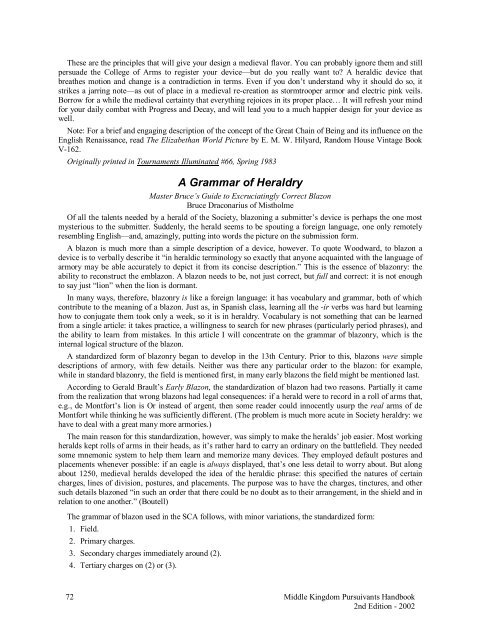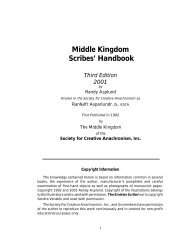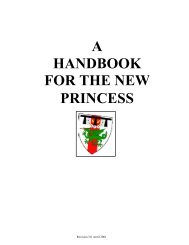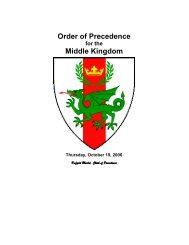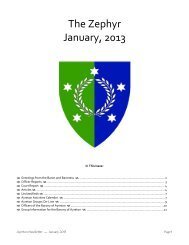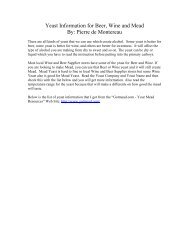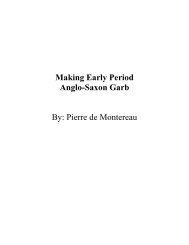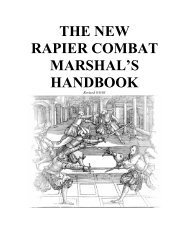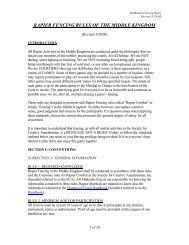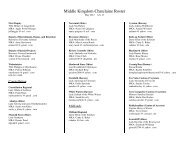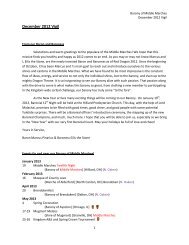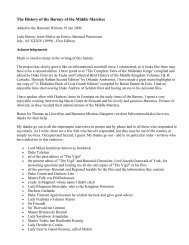These are the principles that will give your design a medieval flavor. You can probably ignore them and stillpersuade the College of Arms to register your device—but do you really want to? A heraldic device thatbreathes motion and change is a contradiction in terms. Even if you don’t understand why it should do so, itstrikes a jarring note—as out of place in a medieval re-creation as stormtrooper armor and electric pink veils.Borrow for a while the medieval certainty that everything rejoices in its proper place… It will refresh your mindfor your daily combat with Progress and Decay, and will lead you to a much happier design for your device aswell.Note: For a brief and engaging description of the concept of the Great Chain of Being and its influence on theEnglish Renaissance, read The Elizabethan World Picture by E. M. W. Hilyard, Random House Vintage BookV-162.Originally printed in Tournaments Illuminated #66, Spring 1983A Grammar of HeraldryMaster Bruce’s Guide to Excruciatingly Correct BlazonBruce Draconarius of MistholmeOf all the talents needed by a herald of the Society, blazoning a submitter’s device is perhaps the one mostmysterious to the submitter. Suddenly, the herald seems to be spouting a foreign language, one only remotelyresembling English—and, amazingly, putting into words the picture on the submission form.A blazon is much more than a simple description of a device, however. To quote Woodward, to blazon adevice is to verbally describe it “in heraldic terminology so exactly that anyone acquainted with the language ofarmory may be able accurately to depict it from its concise description.” This is the essence of blazonry: theability to reconstruct the emblazon. A blazon needs to be, not just correct, but full and correct: it is not enoughto say just “lion” when the lion is dormant.In many ways, therefore, blazonry is like a foreign language: it has vocabulary and grammar, both of whichcontribute to the meaning of a blazon. Just as, in Spanish class, learning all the -ir verbs was hard but learninghow to conjugate them took only a week, so it is in heraldry. Vocabulary is not something that can be learnedfrom a single article: it takes practice, a willingness to search for new phrases (particularly period phrases), andthe ability to learn from mistakes. In this article I will concentrate on the grammar of blazonry, which is theinternal logical structure of the blazon.A standardized form of blazonry began to develop in the 13th Century. Prior to this, blazons were simpledescriptions of armory, with few details. Neither was there any particular order to the blazon: for example,while in standard blazonry, the field is mentioned first, in many early blazons the field might be mentioned last.According to Gerald Brault’s Early Blazon, the standardization of blazon had two reasons. Partially it camefrom the realization that wrong blazons had legal consequences: if a herald were to record in a roll of arms that,e.g., de Montfort’s lion is Or instead of argent, then some reader could innocently usurp the real arms of deMontfort while thinking he was sufficiently different. (The problem is much more acute in Society heraldry: wehave to deal with a great many more armories.)The main reason for this standardization, however, was simply to make the heralds’ job easier. Most workingheralds kept rolls of arms in their heads, as it’s rather hard to carry an ordinary on the battlefield. They neededsome mnemonic system to help them learn and memorize many devices. They employed default postures andplacements whenever possible: if an eagle is always displayed, that’s one less detail to worry about. But alongabout 1250, medieval heralds developed the idea of the heraldic phrase: this specified the natures of certaincharges, lines of division, postures, and placements. The purpose was to have the charges, tinctures, and othersuch details blazoned “in such an order that there could be no doubt as to their arrangement, in the shield and inrelation to one another.” (Boutell)The grammar of blazon used in the SCA follows, with minor variations, the standardized form:1. Field.2. Primary charges.3. Secondary charges immediately around (2).4. Tertiary charges on (2) or (3).72 <strong>Middle</strong> <strong>Kingdom</strong> <strong>Pursuivants</strong> <strong>Handbook</strong><strong>2nd</strong> <strong>Edition</strong> - 2002
5. Peripheral secondary charges.6. Tertiary charges on (5).7. Brisures.8. Augmentations.Charges are blazoned in the above order; this order reflects the visual importance of each group of charges.Let us expand on these categories:FieldIf the device consists solely of a field, the blazon is simple. If the field is plain, the tincture should be given:Ermine (Brittany), or Gules (d’Albret).If the field is parted, the type of division, and any complex lines of partition, must be specified along with thecomponent tinctures. The early forms of English blazon used the phrase “Party per X,” where X was one of theordinaries—Party per fess, for instance. (Scots blazon still use a similar form.) The word “party” was quicklydropped, as it was intuitively obvious; we would simply use Per fess.This is followed by the complex line, if one is used, and the tinctures follow that. Field treatments (e.g.,masoned) are considered part of the tincture, and are blazoned along with it.In specifying the tinctures used, the chief portion of the field is blazoned first. If both portions of the field areequally “in chief,” the dexter portion of the field comes first. Thus in fig.1, the field is divided diagonally (as abend), the white portion is on top, and the line is embattled; this is blazoned Per bend embattled argent andsable. A vertical division has both portions equally in chief, so the dexter portion is blazoned first: then comesthe complex line (wavy, this time), and then the fields and their treatment. Thus fig.2 would be blazoned Perpale wavy argent fretty sable, and sable.Most of the simple, two-part field divisions can be multiplied to form multi-part fields. For instance, Per palecan be multiplied into Paly (Figure 3); Per bend into Bendy; etc. These are blazoned in the same order as theirparent forms. Note that they all have an even number of divisions—usually six or eight, but other numbers canbe specified. If there are an odd number of divisions, the design is not blazoned as a field, but as a group ofordinaries—i.e. in Figure 3 we see the distinction between Paly argent and sable and Argent, three palets sable.The amount of heraldic difference is small-to-negligible, but the distinction is still preserved in the blazon.<strong>Middle</strong> <strong>Kingdom</strong> <strong>Pursuivants</strong> <strong>Handbook</strong> 73<strong>2nd</strong> <strong>Edition</strong> - 2002
- Page 2:
Middle Kingdom Pursuivants Handbook
- Page 5 and 6:
INTRODUCTION.......................
- Page 7 and 8:
Saracens: Early to Mid-Medieval Mus
- Page 9 and 10:
IntroductionOsric of FayrehopeWhat
- Page 11 and 12:
AcknowledgementsMistress Elena de V
- Page 13 and 14:
The Middle KingdomCollege of Herald
- Page 15 and 16:
Regional HeraldsConstellation Heral
- Page 17 and 18:
Pursuivant DutiesDuties of the Bran
- Page 19 and 20:
All submissions should be sent to t
- Page 21 and 22:
What to Report?First of all, your r
- Page 23 and 24:
esponsibility now. It wouldn’t hu
- Page 25 and 26:
simply too pervasive. Chilly weathe
- Page 27 and 28:
switched into the losers’ bracket
- Page 29 and 30:
prevent accusations of a rigged lis
- Page 31 and 32:
the green fabric), a larger spool o
- Page 33 and 34: Precedence and CourtesyCourtly Beha
- Page 35 and 36: Territorial Barons and Baronesses m
- Page 37 and 38: c. Once all presentations appear to
- Page 39 and 40: i. Oaths of Fealty and Acknowledgem
- Page 41 and 42: herald is the voice of the Crown an
- Page 43 and 44: Award of the Dragon's FlightOP Abbr
- Page 45 and 46: Award of ArmsOP Abbreviation - AoAL
- Page 47 and 48: Order of the Red CompanyOP Abbrevia
- Page 49 and 50: Order of the WillowOP Abbreviation
- Page 51 and 52: Order of the Gold MaceOP Abbreviati
- Page 53 and 54: Master of ArmsOP Abbreviation - MSC
- Page 55 and 56: Prince and Princess of NorthshieldO
- Page 57 and 58: - The Consort of Northshield bears
- Page 59 and 60: The Submission ProcessWorking with
- Page 61 and 62: A good consultant will have these e
- Page 63 and 64: submit it anyway (“I may be wrong
- Page 65 and 66: Internal Letter Of Acceptance And R
- Page 67 and 68: NamesOn Names and Name Documentatio
- Page 69 and 70: Choosing a CultureJehan de la March
- Page 71 and 72: Clothing: For the Slavic groups, pr
- Page 73 and 74: Politics: The entire Islamic world
- Page 75 and 76: Although in the earlier Middle Ages
- Page 77 and 78: character in Household’s Arabesqu
- Page 79 and 80: An Extremely Brief BibliographyWest
- Page 81 and 82: ArmoryThe Philosophical Roots of He
- Page 83: Even if your natural instinct for a
- Page 87 and 88: Brisures (marks of cadency) and aug
- Page 89 and 90: Still found in mundane blazons are
- Page 91 and 92: Efficient Conflict ResearchKeridwen
- Page 93 and 94: 1. Is there a peripheral charge (a
- Page 95 and 96: checking under the old rules, the s
- Page 97 and 98: 2. Yes, the peripheral is charged.
- Page 99 and 100: Many authors state that dancetty is
- Page 101 and 102: Charges may be placed on either sid
- Page 103 and 104: It’s a bit more complicated to ke
- Page 105 and 106: This page shows properly drawn exam
- Page 107 and 108: This page shows a number of common
- Page 109 and 110: Postures of Animals (cont’d)Posit
- Page 111 and 112: Postures of BirdsPosition & Comment
- Page 113 and 114: Postures of Fish and DolphinsPositi
- Page 115 and 116: Barony of Caer Anterth MawrAzure, a
- Page 117 and 118: Barony of the North WoodsAzure, a w
- Page 119 and 120: Shire of AfonlynAzure, on a bend ar
- Page 121 and 122: Shire of Rivenwood TowerErmine, on
- Page 123 and 124: Reference BooksThe Basic HeraldBron
- Page 125 and 126: Bardsley, Charles Wareing. English
- Page 127 and 128: Kaganoff, Benzion C. A Dictionary o
- Page 129 and 130: Sims, Clifford Stanley. The Origin
- Page 131 and 132: Moncreiffe, Iain, and Don Pottinger
- Page 133 and 134: Bruce Draconarius of Mistholme and
- Page 135 and 136:
Rules and RegulationsRules for Subm
- Page 137 and 138:
Although China, Random and Starhawk
- Page 139 and 140:
iii. Heraldic Titles - Heraldic tit
- Page 141 and 142:
ii. Number of Name Phrases - A pers
- Page 143 and 144:
PART VII - COMPATIBLE ARMORIAL CONT
- Page 145 and 146:
i. A metal and a color;ii. An eleme
- Page 147 and 148:
PART IX - OFFENSIVE ARMORYOffensive
- Page 149 and 150:
ii. Field-Primary Armory - If neith
- Page 151 and 152:
j. Changes to Charges on Charges -
- Page 153 and 154:
3. Marshalling. - Armory that appea
- Page 155 and 156:
directly by individuals, but may be
- Page 157 and 158:
the Laurel Office from the registra
- Page 159 and 160:
charge or augmentation is transferr
- Page 161 and 162:
so that ð is alphabetized as dh,
- Page 163 and 164:
1. Failure to Comment. Failure to c
- Page 165 and 166:
B. Content of Letters of Acceptance
- Page 167 and 168:
1. Principal Heralds - The Principa
- Page 169 and 170:
1. Financial Reports - Financial re
- Page 171 and 172:
Appendix B - Standard Designations
- Page 173 and 174:
Appendix D - Suggested Standard For
- Page 175 and 176:
Appendix G - Role of the Deputy Sov
- Page 177 and 178:
Glossary of TermsThis glossary was
- Page 179 and 180:
Complement, In Her*—Describes the
- Page 181 and 182:
Fur—Some furs, like Vair, Potent
- Page 183 and 184:
Mon—Japanese armorial insignia†
- Page 185 and 186:
Registration—Acceptance by Laurel
- Page 187 and 188:
AppendicesSources for Heraldic Publ
- Page 189 and 190:
• Send the four copies in and kee
- Page 191 and 192:
“Major” or “minor” changes?
- Page 193 and 194:
See the General section at the begi


